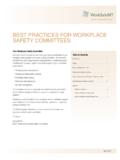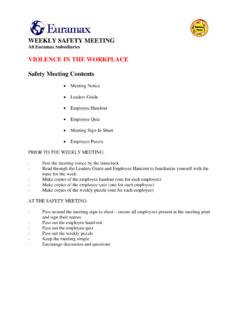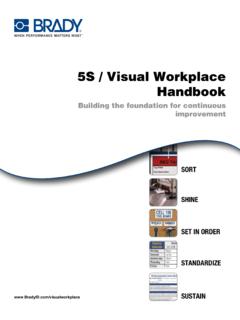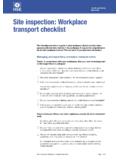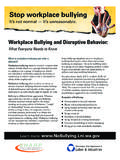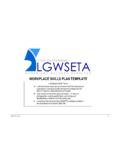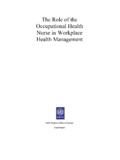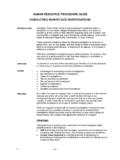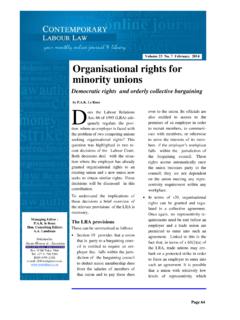Transcription of WHO Healthy Workplace Framework and Model
1 WHO Healthy Workplace Framework and Model : Background and Supporting Literature and Practices by Joan Burton Readers comments: Kazutaka Kogi, President, International Commission on Occupational Health: The draft Framework is well framed and excellently prepared. The document will be a solid basis for future developments in promoting Healthy workplaces internationally. Tom Shakespeare, World Health Organization, Headquarters: Excellent review of evidence; good, clear, workable conclusions and recommendations. Marilyn Fingerhut, National Institute for Occupational Safety and Health, USA This is a great document!
2 Enjoyed reading it! Wolf Kirsten, International Health Consulting: Well done on the comprehensive approach covering the key areas and at the same time keeping it simple and avoiding long and complex scientific constructs. Teri Palermo, National Institute for Occupational Safety and Health, USA: Congratulations on an impressive and useful document. The attention to psychosocial issues, work-life balance, mental health issues and their impact on the safety and health of the workforce is important and not always recognized. I also liked your discussion of the need and challenges regarding rigorous evaluation of interventions including cost-effectiveness.
3 The Framework is comprehensive and provides a useful guidance for program development. Fintan Hurley and Joanne Crawford, Institute of Occupational Medicine, Edinburgh, Scotland, UK We found this a very interesting, well-informed, wide-ranging and useful report. It includes a great deal of useful information. It is written in an accessible style, which we both liked. Wendy Macdonald, Centre for Ergonomics & Human Factors, La Trobe University, Victoria, Australia I think this is an outstandingly good document that will be extremely useful, and for the most part is beautifully written. Congratulations to the author and the others who have It s a pleasure to see so many important issues linked together and discussed (very usefully) in the one document a real tour de force.
4 Rob Gr ndemann, TNO, The Netherlands: I have read the document with great pleasure. It gives a good and comprehensive overview of the state of the art on actions directed at Workplace health and the research on the effectiveness of Workplace health interventions. February 2010 Submitted to Evelyn Kortum WHO Headquarters, Geneva, Switzerland Table of Contents Table of Contents .. Page i List of Tables and Figures .. iii Acknowledgements .. iv Executive Summary .. 1 Chapter 1: Why Develop a Healthy Workplace Framework ? .. A. It is The Right Thing To Do: Business Ethics .. B.
5 It is The Smart Thing To Do: The Business Case .. C. It is the Legal Thing to Do: The D. Why a Global Framework ?.. 5 5 6 7 7 Chapter 2: History of Global Efforts To Improve Worker Health .. 11 Chapter 3: What Is a Healthy Workplace ? .. A. General Definitions .. B. The WHO Definition of a Healthy C. Regional Approaches To Healthy Workplaces .. 1. Regional Office For Africa (AFRO) .. 2. Regional Office For the Americas (AMRO) .. 3. Regional Office For the Eastern Mediterranean (EMRO).. 4. Regional Office For Europe (EURO) .. 5. Regional Office For South-East Asia (SEARO).
6 6. Regional Office For the Western Pacific (WPRO).. 15 15 16 17 17 17 20 21 22 23 Chapter 4: Interrelationships of Work, Health and A. How Work Affects the Health of Workers .. 1. Work Influences Physical Safety and 2. Work Affects Mental Health and 3. 4. The Positive Impact of Work on Health .. B. How Worker Health Affects the 1. Accidents and Acute Injuries Affect the Enterprise .. 2. The Physical Health of Workers Affects the Enterprise .. 3. The Mental Health of Workers Affects the C. How Worker Health and the Community Are Interrelated .. 25 25 25 28 32 33 34 34 35 36 37 Chapter 5: Evaluating Interventions.
7 A. The Cochrane Collaboration .. B. General Evaluation Criteria .. C. Grey Literature .. D. The Precautionary Principle .. E. Interrelatedness of Worker Participation and Evaluation Evidence .. F. Evaluating the Cost-Effectiveness of Interventions .. 41 41 41 43 43 44 44 Chapter 6: Evidence For Interventions That Make Workplaces Healthier .. A. Evidence For Effectiveness of Occupational Health & Safety Interventions .. B. Evidence For Effectiveness of Psychosocial/Organizational Culture Interventions C. Evidence For Effectiveness of Personal Health Resources in the Workplace .. D.
8 Evidence For Effectiveness of Enterprise Involvement in the Community .. i 47 47 49 51 55 Chapter 7: The Process: How To Create a Healthy Workplace .. A. Continual Improvement Process Models .. B. Are Continual Improvement/OSH Management Systems Effective? .. C. Key Features of the Continual Improvement Process in Health & 1. Leadership Engagement based on Core Values .. 2. Involve Workers and their 3. Gap 4. Learn from 5. D. The Importance of Integration .. 59 59 61 62 62 62 63 64 64 65 Chapter 8: Global Legal and Policy Context of Workplace A. Standards-setting B.
9 Global Status of Occupational Health & C. Workers Compensation .. D. Trade Union Legislation .. E. Employment F. Psychosocial Hazards .. G. Personal Health Resources in the Workplace .. H. Enterprise Involvement in the Community .. I. The Informal Economic Sector .. 69 70 72 73 75 76 78 79 80 81 Chapter 9: The WHO Framework and A. Avenues of Influence for a Healthy Workplace .. 1. The Physical Work Environment .. 2. The Psychosocial Work Environment .. 3. Personal Health Resources in the Workplace .. 4. Enterprise Community B. Process For Implementing a Healthy Workplace Programme.
10 1. 2. 3. 4. 5. 6. 7. 8. C. Graphical Depiction .. D. Basic Occupational Health Services the Link .. E. The Broader Context .. F. Conclusion .. 82 83 84 85 86 87 89 89 90 90 92 93 94 94 96 96 96 97 98 Annex 1: Acronyms Used in this Document .. 99 Annex 2: Glossary of Terms and Phrases .. 101 Endnotes .. 108 iiNOTE ABOUT THE INSERTED QUOTATIONS: Throughout this document there are numerous quotations inserted in text boxes on the pages. Each has a designation at the bottom as Interview #xx [Country], [Profession] These are quotations taken from the transcription of 44 interviews with global professionals from various disciplines, carried out for WHO by Stephanie Mia McDonald, Institute of Work, Health and Organisations, University of Nottingham, during July and August, 2009.










